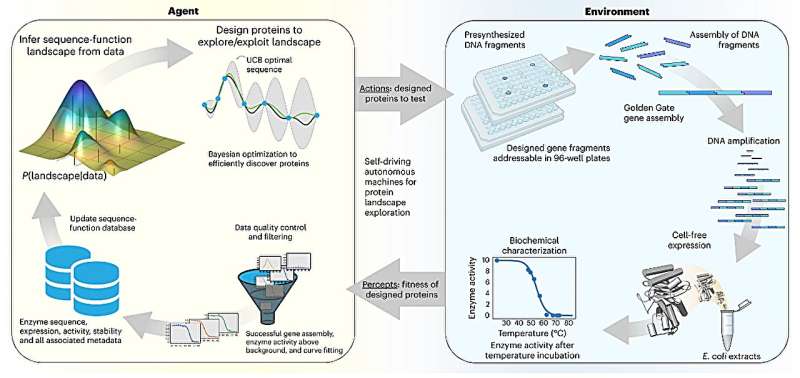January 15, 2024 report
This article has been reviewed according to Science X's editorial process and policies. Editors have highlighted the following attributes while ensuring the content's credibility:
fact-checked
trusted source
proofread
Automated laboratory system uses robotic equipment directed by AI to reengineer enzymes

A trio of biochemists at the University of Wisconsin–Madison has developed a system that automates the process of reengineering enzymes using robotic equipment and an AI model. In their paper published in the journal Nature Chemical Engineering, Jacob Rapp, Bennett Bremer and Philip Romero describe their system.
Reengineering enzymes is a process in which chemists subject a test enzyme to experiments, hoping to create a similar enzyme with desired properties, for example, being able to withstand exposure to higher-than-normal temperatures. The current process involves time-consuming and monotonous screening, and chemists would welcome a way to automate the process. In this new effort, the research team has done just that.
The researchers used a facility hosting robots that conduct chemistry experiments. They added an AI model that was able to both monitor the experiments and use their results as a starting point for new experiments. The idea was to allow the system to learn as it worked. Unfortunately, the team found that conventional robotics equipment was not up to the task—they ended up farming out that part of their system to a cloud-based company that specializes in remote chemistry work.
After setting up their system and tweaking it to improve results, the researchers tested it by identifying a group of enzymes and then prompting the system to find new versions that could continue to function normally when exposed to higher temperatures. They gave the system 20 rounds to come up with the newly engineered enzymes and the system produced four—each able to operate in environments 12°C higher than normal.
The research team concludes that their approach is viable, though they note that for it to be truly useful, a new generation of robotic hardware will have to be developed to full take advantage of its possibilities.
More information: Jacob T. Rapp et al, Self-driving laboratories to autonomously navigate the protein fitness landscape, Nature Chemical Engineering (2024). DOI: 10.1038/s44286-023-00002-4
© 2024 Science X Network





















